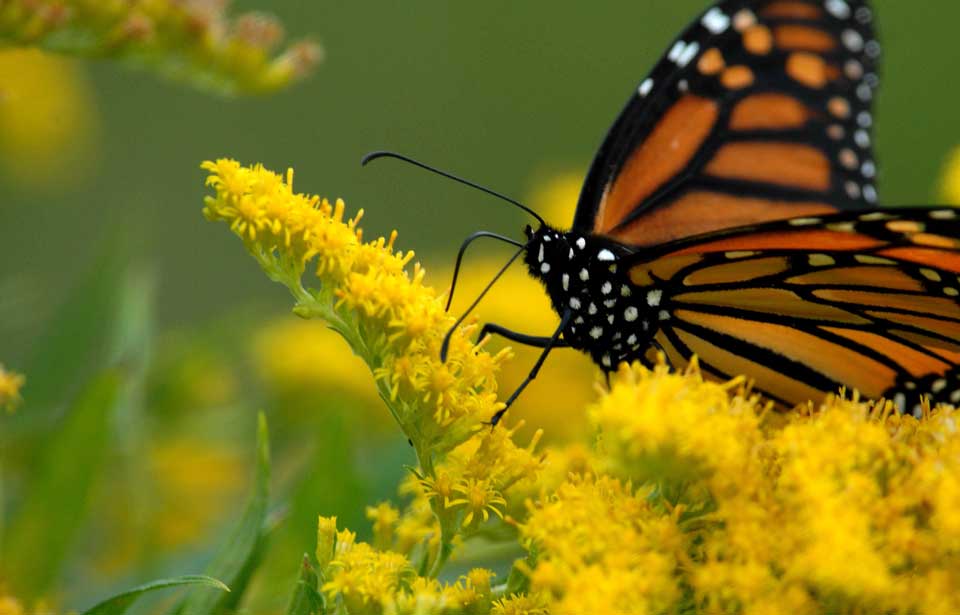The next hummingbird or butterfly that hovers your way could be following a “nectar corridor.”
Certain species migrate over paths that stretch thousands of kilometres in length while pursuing plants that bloom sequentially — north to south in fall, south to north in spring. These pollinating pilgrims need nectar to fuel their long-distance flights. In exchange, they unknowingly transfer pollen from bloom to bloom. This process, known as cross-fertilization, ensures the reproduction and genetic mixing of wild plants and cultivated crops.
Today, this essential service is threatened by pollution and pesticides as well as by habitat fragmentation resulting from land developments like industries, parking lots, and shopping malls.
Many nectar corridors are no longer intact. Travellers must “island hop” across scattered habitats that contain little food. This lack of fuel is much to blame for dramatically decreasing populations among migratory pollinators. At stake is their future and the critical role played by pollination in sustaining natural communities and in putting food on our plates.
It’s time we rose to the challenge of nurturing nectar corridors back to health. Here’s how you can help:
- Spread the word about the inestimable value of pollinators. Use posters, stories, poems, speeches, and other media to make a statement.
- Find out if there’s an important pollinator stopover in your area. Seek advice from an entomologist at a local university or your regional natural resources ministry.
- If the site is at risk, consider habitat enhancement strategies, such as the pollinator projects below.
- Adopt the migratory stopover and ask your community to declare it a pollinator preserve.
- Work with other communities along the same corridor. Share information, discuss conservation concerns, and collaborate on pollinator projects.
- Purge pesticides from your municipality. See “Purge Pesticides From Your Schoolyard and Community” for suggestions on how to persuade your town council to impose a ban on bug and weed killers.
Provide Pollinator Pit Stops
Invite pollinators into a courtyard or other parts of your school grounds where once the bravest butterflies dared not go. Make the invitation irresistible by growing wildflowers laden with nectar and pollen in containers of all kinds. The perfect project for inner city schools with scarce land and funds, container gardening provides wildlife habitat that is both productive and portable — a moveable feast.
- Collect an array of planting containers — ones made of wood, metal, plastic, clay, or ceramic. Anything that holds soil and is large enough to allow healthy plant growth — tin cans, milk pails, old buckets, feeding troughs, waste-paper baskets, wheelbarrows, rusty wagons, enamel basins, half whisky barrels, orange crates lined with plastic, flue tiles or drain pipes standing on end — will do beautifully.
- Poke or drill drainage holes in container bottoms. Add a layer of pebbles to encourage seepage. Fill pots with moisture-retaining soil.
- Select an array of native annual blooms to attract an array of pollinators (see “Pollinator Plants” below). Perennials must be planted in the ground or brought indoors to survive the winter.
- Place containers in sunny, preferably sheltered, parts of your courtyard. Arrange them on surfaces, such as planks laid across cement blocks and multi-level shelves or “terraces” made of plastic-coated metal. Nestle larger receptacles in corners. Hang planters from arbours, fences, railings, arches, and walls. Use lattices and trellises to support vines planted in pots on the ground.
- Water plants regularly, especially those in smaller containers, until they’re established.
A Square Yard in Your Schoolyard or Backyard
The amount of land at your command may seem too puny to make a difference in the grand scheme of things. But even a bounteously blooming square yard (or a square metre) could constitute a small but significant part of a nectar corridor. That’s where “biointensive gardening” — the practice of growing closely spaced wild plants in miniature plots — comes in.
- Select a well-drained spot that receives six to eight hours of sunshine a day. Both sides of the entrance to your school, a private home, or seniors’ residence are ideal locations.
- Think small. Just one or two square-metre gardens could meet your objectives.
- Circumscribe your plot with string, bricks, or preferably lumber. A raised bed enclosed in four-by-four landscaping timber (untreated) offers several advantages: protection from foot traffic, better drainage, deeper topsoil, and easier accessibility.
- Till the soil to a depth of at least 30 centimetres. Then mix in one part compost or wellaged manure to two parts existing soil.
- Divide the plot into 16 squares with string. Each square will hold a different species of wildflower (see “Pollinator Plants” below).
- Plant several seedlings or pinches of seeds in each square, in closely spaced, slightly staggered rows.
- Water the plot regularly, especially during dry weather.
Pollinator Plants
- Hummingbirds and swallowtail butterflies favour red flowers with bell, tube, and trumpet shapes. Fireweed, columbine, salvia, day-lily, trumpet honeysuckle, cardinal-flower, delphinium, blazing-star, phlox, and wild geranium are some of their favourites.
- The best nectar choices for adult butterflies are dogbane, asters, milkweed, goldenrod, fleabane, thistle, peony, lupine, vetch, and phlox.
- Good sources of nourishment for butterfly caterpillars include sedum, violet, clover, black-eyed Susan, and Queen Anne’s-lace.
- Monarch butterfly caterpillars eat only milkweed. Widely regarded as a noxious plant, common milkweed has several close relatives — including butterfly-weed, red milkweed, and swamp milkweed — all of which are good hosts to monarch larvae. Ask a bylaws officer if these plants can be grown in your area.



